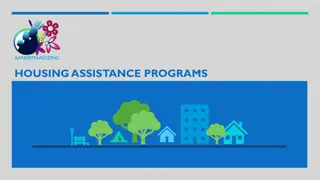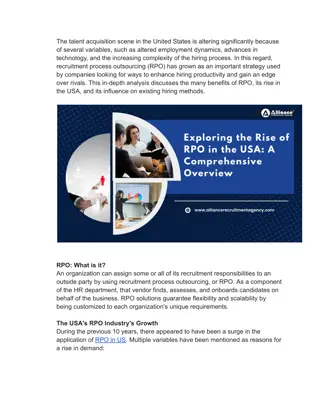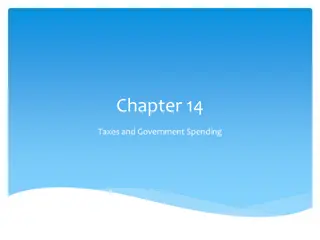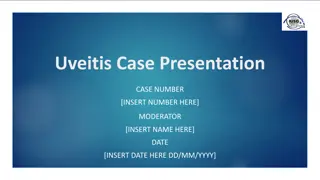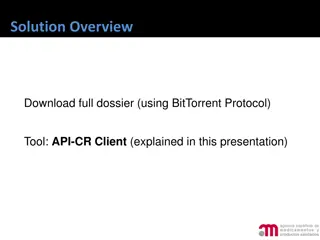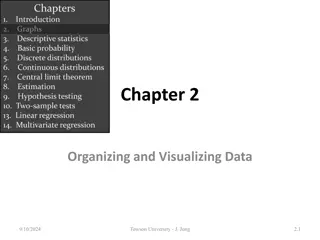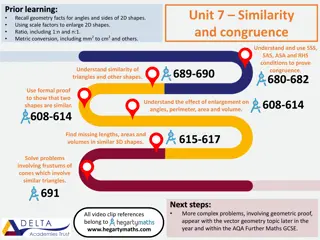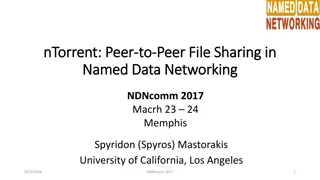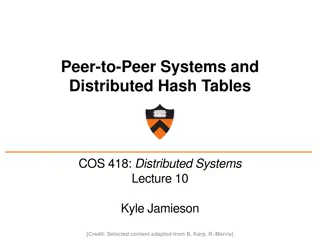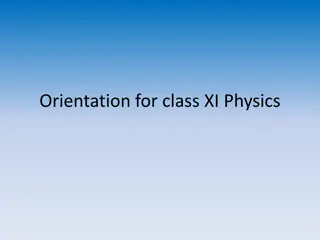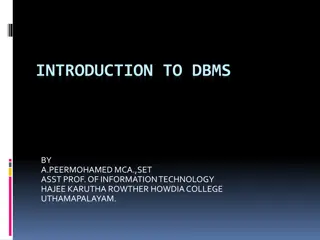Understanding BitTorrent: A Comprehensive Overview
BitTorrent is a decentralized file sharing system with distinct levels of control and reciprocation involving components like data content, trackers, and peers. Roles within a torrent ecosystem are defined, and the importance of metainfo files for initiating downloads is highlighted. Prior to actual operation, peers communicate with trackers through specific HTTP requests to facilitate file sharing seamlessly.
Download Presentation

Please find below an Image/Link to download the presentation.
The content on the website is provided AS IS for your information and personal use only. It may not be sold, licensed, or shared on other websites without obtaining consent from the author. Download presentation by click this link. If you encounter any issues during the download, it is possible that the publisher has removed the file from their server.
E N D
Presentation Transcript
Description BitTorrent is a centralized unstructured system, which consists of two interacting units: A control level describes control methods such as the required file sharing preparation, which takes place prior to sharing the actual content, and the coordination among end hosts, which is performed by a central entity during the downloading process. A reciprocation level describes the actual data exchange among the end hosts.
Bittorent control level The BitTorrent content distribution system consists of the following components: Data content An original content provider The metainfo file The tracker The end hosts or peers or clients
Roles A torrent, or swarm, is a collection of end hosts (or peers) participating in the download of content, where content may refer to one (e.g. the Linux operating system) or multiple (e.g. several video or audio) files. The tracker is a server that coordinates and assists the peers in the swarm. It maintains the list of peers that are currently in the swarm, as well as statistics about the peers. The tracker listens on a BitTorrent TCP port for coming client requests. Prior to the content distribution, a content provider divides the content into multiple pieces, where each piece is typically 256KB. Each piece is further divided into multiple subpieces with a typical size of 16KB. The content provider then creates a metainfo file.
Metainfo file The metainfo file contains information that is necessary for initiating and maintaining the download process. For example, the metainfo file contains the URL of the tracker, the name of the data file (files), the length of the data file (files), and the length of a piece. The metainfo file may also contain information related to multiple data files, and optional information such as creation date, author s comments, name and version of the .torrent creator, etc. The metainfo file also contains a special string, which is a concatenation of 20-byte encoded hash values. Each value is a SHA-1 hash of a piece at the corresponding data content, which is used for data integrity.
Peer operation A peer that is willing to join the swarm first retrieves the out-of-band metainfo file. Then, this peer contacts the tracker by sending an announce HTTP GET request. The request in general may include necessary information such as the total amount uploaded, the total amount downloaded, the number of bytes the peer still has to download, an event description such as started if it is the first request to the tracker, completed if the peer shut down gracefully, stopped if the download completed. This information helps the tracker keep overall statistics about the torrent (e.g., number of seeds, number of leechers, life time of a seed, etc.) The tracker responds back with a "text/plain" document, which includes a randomly selected set of peers that are currently online. A typical size of a peer set is 50. The random peer set may include both seeds and leechers. Seeds are the peers who already have the entire content and are sharing it with others. Leechers are the peers who are still in the process of downloading (i.e. they do not possess the entire file). The new peer can then initiate new connections with the peers in the swarm and start to exchange data content pieces. The maximum number of connections that a peer can open is limited in BitTorrent to 80 in order to avoid performance degradation due to competition among concurrent TCP flows. In addition, the new peer is also limited to establish a fixed number of outgoing connections, typically 40, in order to ensure that some connection slots are kept available for new peers that will join at a later time.
Peer operation (cont.) A peer that has already begun downloading may contact the tracker and ask for more peers if its peer set falls below a given threshold, which is typically set to 20 peers. Usually there is a minimum interval between two consecutive peer requests to avoid overwhelming the tracker. Peers contact the tracker periodically, typically once every 30 minutes, to indicate that they are still present in the network. If a peer does not contact the tracker for more than 45 minutes, the tracker assumes that the peer has left the system and will remove the peer from the torrent list.
Bittorent Reciprocation Level The connection between two peers starts with a handshake message followed by control and data message exchanges. The control messages between peers in the swarm as well as data messages are transferred over the TCP protocol. The range of TCP ports, which is used by BitTorrent clients is 6881- 6999. The connection between peers is symmetric and the control messages in both directions have the same format. Data can flow in either direction.
Bittorrent messages the handshake message is a required message that ensures connections from both sides and must be the first message that is sent by the peer. the bitfield message is an optional message and may only be sent after the handshaking sequence is completed, and before any other messages are sent. A peer can choose not to send this message if it has no pieces. Using a single bit for every piece, bits that are set indicate valid and available pieces, which can be shared with other peers, and bits that are cleared indicate missing pieces, which must be downloaded from other peers. Interested: an interested message is a notification that the sender is interested in some of the receiver s data pieces. Not-interested: a not-interested message is a notification that the sender is not interested in any of the receiver s data pieces. Choke: the term choke is commonly used in BitTorrent as a verb that describes a temporary refusal to upload. A choke message is a notification that the sender will not upload data to the receiver until unchoking happens. Unchoke: An unchoke message is a notification that the sender peer will upload data to the receiver if the receiver is interested in some of the sender s data pieces. Request: a request message is used to request a subpiece. Piece: a piece message is sent in response to a request message, and contains the requested subpiece. Have: a have message describes the index of a piece that has been downloaded and verified via the SHA-1 hash function. Keep-alive: Peers may close the TCP connection if they have not received any messages for a given period of time, generally 2 minutes. Thus, the keep-alive message is sent to keep the connection between two peers alive, if no message has been sent in a given period of time. Cancel: a cancel message is used to cancel subpiece requests. It is mostly sent towards the end of the download process
Peer swarm state A peer A in the swarm maintains a 2-bits connection state for every associated peer B that it is connected to. The first bit is the choking/unchoking bit. The second bit is the interested/notinterested bit. The connection state is initialized to choked and not interested. Peer B transfers data to peer A only if the state of the connection with A is unchoked and interested. Peer B responds to peer A s request messages with encapsulated subpieces in piece messages. After peer A finishes downloading a piece, it verifies that the piece is uncorrupted. It calculates the SHA-1 value of the downloaded piece and compares this value with the encrypted reference value of the piece that is given in the metainfo file. After verifying that the piece is uncorrupted, peer A announces that it has the piece to all of its associated peers using the have message.
Flow of messages (cont.) Possible message flow among peers that have an active connection. Connection is established after peer A sends a handshake message, and B replies with one as well. Then, peer B sends a bitfield message but peer A does not (if A has no piece ready to be shared). Peer B sends a not interested message to A, and A sends a choke message to B. Data will not flow from peer A to peer B until both messages are replaced. On the other hand, data does flow from peer B to peer A because peer A sends an interested message to peer B and peer B sends an unchoked message to peer A. Then, peer A requests subpieces of a particular piece and B responds with piece messages, uploading the requested subpieces. Once peer A obtains the entire piece and confirms the validity of the piece, it sends have messages to all the peers that it is connected to in the BitTorrent overlay network.
Piece selection mechanism Peers download the data content in a random order, unlike other protocols such as http or ftp, where an end host downloads a file from beginning to end. In order to facilitate such a downloading process, when a BitTorrent application is activated in a peer, the peer first allocates space for the entire content. Then, the peer tracks the pieces that each of its associated peers possess. A peer is able to identify what pieces its associated peers have by exchanging bitfield messages upon establishing new connections and by tracking the have messages that associated peers send after downloading and verifying pieces. Thus, a peer is able to select a particular piece to download from a particular associated peer. The piece selection mechanism is fundamental in achieving efficient P2P networks. A poor selection strategy can lead to an inability to download, e.g., when a peer is not interested in any of the pieces its associated peers can offer, and vice versa, it can lead to the inability to upload, e.g., when all associated peers are not interested in the pieces that a peer has to offer. Components: Random Piece First, Rarest Piece First, End Game.
Rarest Piece First The rarest piece is the piece that has the least amount of copies in the swarm. For every piece, the peer maintains a counter of the number of copies that exists in its peer set. A peer, which runs the rarest piece first selection algorithm, selects the rarest missing piece as the next piece to download. If there are multiple equally-rare missing pieces, then the peer chooses at random to download one of the rarest pieces. A leecher that uses the rarest piece first algorithm will: 1. Upload pieces that many of the associated peers are interested in, such that uploading can be performed when needed. 2. Increase the likelihood that peers will offer pieces through the entire downloading process by leaving pieces that are more common to a later download. 3. When downloading from a seed, a leecher downloads new pieces first, where new pieces are those pieces that no leecher has. This is crucial, especially when the system has a single seed that may eventually be taken down, since this can lead to the risk that a particular piece will no longer be available. This is also important when the seeds in the system are slower than the leechers in the system. In this case, a redundant download wastes the opportunity of a seed to upload new pieces to associated peers with faster uploader speeds.
Random Piece First The download time of a random piece will be shorter on average than the download time of the rarest piece. A piece that is chosen at random is likely to be more replicated than the rarest piece, and thus, its download time will be shorter on average by downloading simultaneously from more peers. The download time of complete piece may not affect the performance of a peer that uses the rarest-first piece selection strategy if the peer has other complete pieces to share. At the beginning of the downloading process, a leecher has no pieces to share, and thus, the leecher should download pieces faster than in the rarest-first piece selection strategy, as it is important for a new peer to obtain some complete pieces and to start reciprocate pieces. Hence, at the beginning of the process the peer selects a piece to download at random, while applying the random piece first selection algorithm. Once the peer downloads C pieces that are ready to be shared (C is a constant that may vary in different BitTorrent client implementations), the leecher switches to the rarest piece first selection algorithm.
End Game Piece Selection The end game piece selection algorithm is performed after a peer has requested all the subpieces of the content. In this phase, a peer sends a request to all of its associated peers for all of the pending subpieces (i.e., those subpieces that have not been received yet). This step is performed in order to avoid potential delays at the end of the content download, which can occur if a request has been sent to a peer having a very slow upload rate instead of a peer having a fast upload rate. Since multiple requests for the same subpieces are sent out, once a subpiece is downloaded in the end game phase, the peer sends cancel messages to its associated peers so they do not waste upload bandwidth by sending redundant data. The end game is performed at the very end of the process, and thus, it may have only a small impact on the downloading process.
Peer Selection Mechanisms Peers download from whom they can, and upload simultaneously to a constant number of peers. The number of associated peers, which a peer uploads to, is limited in order to avoid sending data over many connections at once, which may result in poor TCP congestion control behavior. Thus, peers need to make decisions on which peers to unchoke. The default number of peers to unchoke (unchoke slots) is four. However, this number may increase unless a peer s upload bandwidth is saturated. A peer independently makes the decision regarding whom to unchoke and whom to choke, in every unchoke period which is typically ten seconds. The peer uploads to unchoked peers for the duration of the unchoke period. The peer selection mechanism, which is also referred to as the choking mechanism, can affect the performance of the system. A good choking mechanism should: Motivate peers to contribute and upload data to the network, Utilize all available resources, Be robust against free-riding behaviors where peers only download and do not upload. In BitTorrent, the peer selection (choking) mechanism is applied differently to peers that are leechers and those that are seeds.
Leechers peer selection - TFT In the TFT peer selection mechanism, a leecher decides to unchoke peers from which it currently downloads data. It chooses the peers who have the highest upload rate. The idea of TFT is to have several connections that actively transfer data in both directions at any time. In order to avoid wasting of resources due to rapidly choking and unchoking peers, the designer of the protocol sets the rechoke period to 10 seconds.
Optimistic Unchoking BitTorrent applies the optimistic unchoking mechanism in parallel with the TFT mechanism. The goals of the optimistic unchoke mechanism are: 1) to enable a continuous discovery of better peers to reciprocate with, 2) to integrate new leechers that do not have any content pieces to download some data and start reciprocate pieces with others. The optimistic unchoke mechanism chooses to unchoke a peer randomly regardless of its current upload rate. Optimistic unchoke is rotated every optimistic unchoke period, when an optimistically unchoked peer is unchoked for the entire optimistic unchoke period. The designer of the protocol chose the optimistic unchoke duration to be 30 seconds, because 30 seconds is enough time for the upload to get to full capacity, for the download to reciprocate, and finally for the download to get to full capacity. Optimistic unchoke is typically applied on a single unchoke slot while TFT is applied on the rest of the unchoke slots.




